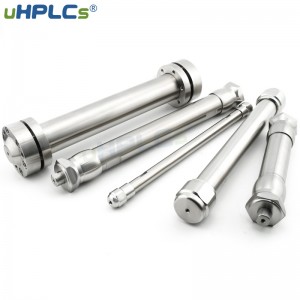This paper aims to analyze the common phenomenon of the solvent effect in high-performance liquid chromatography, explore the principle of forming solvent effect, and propose corresponding solutions to provide corresponding guidelines for related practice.

I. Overview
The term “solvent effect” is used in three fields of UV-Vis spectrophotometry, high-performance liquid chromatography (HPLC) and gas chromatography, and it has different meanings. The other methods, such as normal phase chromatography, ion chromatography, hydrophilic interaction chromatography, etc., can be referred to as the analytical methods and related principles in this paper.
II. What is the solvent effect?
The more recognized understanding of the solvent effect is the chromatographic peak distortion when the diluent’s solvent strength is greater than that of the mobile phase. Suppose the sample is dissolved with pure acetonitrile and injected into the reversed-phase system with the mobile phase of acetonitrile-water (18:82). In that case, it will cause the peak bifurcation or trailing results. However, this concept cannot explain other abnormal chromatographic behaviours caused by diluents in practice, such as the abnormal peak shape of the main peak of the dissolved sample in the pH 6.8 dissolution medium in the dissolution curve study, or the peak bifurcation after the addition of SDS co-solvent, in which the solvent strength of the diluent is not necessarily greater than that of the mobile phase, but the abnormal chromatographic behaviour occurs.
Because the current solvent effect cannot explain many abnormal chromatographic behaviours caused by diluents, I think it is necessary to reformulate the concept of solvent effect: solvent effect refers to the adverse effect on chromatographic behaviours due to the difference in the state of specific components of the test article in the diluent and mobile phase. If this adverse effect is more serious, it may cause obvious abnormalities in chromatographic behaviour, such as peak bifurcation, trailing, etc.
III. Characterization of solvent effect
The solvent effect is an adverse effect on chromatographic behaviour, and the characterization of chromatographic behaviour varies with different degrees of influence; the lighter effect may not have obvious abnormalities in chromatographic behaviour such as unobservable mild peak broadening, etc., the next level may show obvious peak broadening and low column efficiency, and the more serious manifestations include unstable retention time of specific component peaks, abnormal peak shape, unstable response value, etc.
Peak shape abnormalities are the most intuitive and common manifestations of solvent effects, such as peak bifurcation, trailing, leading edge, etc. Varying retention times and unstable response values are also more common manifestations and may be accompanied by abnormal peak shapes; the more difficult-to-detect solvent effects are normal peaks with large fluctuations in response values, which can be easily misjudged as a result of instrument failure and other system applicability. It is recommended to assess the risk of solvent effect.
The solvent effect has certain rules, such as the peaks of components with short retention times are more likely to occur, the peaks of components with later peaks in multi-component chromatograms are better, and the reduction of injection volume can generally alleviate, etc. According to this law, a preliminary judgment can be made on whether the abnormal chromatographic behaviour is a solvent effect.
IV. Principle of solvent effect and its solution
As mentioned above, the solvent effect is the adverse effect of the difference in the state of specific components in the diluent and mobile phase on the chromatographic behaviour. The difference mainly includes elution capacity, ionization state, ion association, mutual equilibrium, etc.
1 Elution capacity
The general understanding of those mentioned above is “pure acetonitrile dissolved sample injected into a reversed-phase system with acetonitrile-water (18:82) as the mobile phase will result in peak bifurcation or tailing”. If the elution capacity of the diluent is greater than that of the mobile phase, this may lead to solvent effects.
The solution is to adjust the diluent or mobile phase so that the elution capacity of the two is close or the elution capacity of the diluent is lower than that of the mobile phase. In general, to avoid the solvent effect caused by elution capacity, it is more prudent in reversed-phase chromatography that the proportion of the organic phase in diluent is lower than a mobile phase or equivalent or slightly higher than the mobile phase if it is necessary. Still, the risk of solvent effect should be assessed, such as judging according to the law mentioned above, etc.
2 Ionization state
Many active ingredients of drugs can be ionized, such as amlodipine besylate, potassium penicillin, etc. Most of these compounds are not strong electrolytes and can only be partially ionized; that is, part of the ionization equilibrium is the ionic state, and the other part is the molecular state, and the distribution of the two states in the stationary phase and the mobile phase is not the same. In reversed-phase systems, the molecular state is more closely bound to the stationary phase and is more strongly retained, while the ionic state is more inclined to the mobile phase and is weaker.
Imagine a situation where the sample is a basic compound, the diluent is a pH 6.8 buffered salt solution (more common in dissolution curve studies), and the mobile phase is a pH 3.0 phosphate solution-organic phase system, which has a very high potential to lead to solvent effects with significant peak shape anomalies. Because the ionization state of the sample in the pH 6.8 buffered salt solution is much lower than that of the pH 3.0 phosphate solution, the process of mixing the test solution with the mobile phase requires a period to buffer the ionization state from the diluent to the mobile phase, and if this time is longer for some reasons (diluent is a buffered salt, mobile phase buffering capacity is weak, etc.), the peak of the component to be measured is very likely to have a significant peak shape anomaly.
There are generally four solutions to the solvent effect in this case:
- Replace the diluent so that the ionization state of the measured material in the diluent is consistent with or close to the mobile phase.
- Reduce the sample volume.
- Add counter ions to the mobile phase or increase the buffering capacity of the mobile phase.
3 Ionic Conjugation
This is commonly seen in tests where the peak of the component to be measured may be severely distorted, or the retention time may fluctuate greatly due to the poor solubility of the substance to be measured in diluents containing sodium dodecyl sulfate. If the TOD is a basic compound, the reason is that the action of the TOD in the ionic state forms an ionic linkage with the dodecyl sulfate anion, and the retention of this substance in reversed-phase chromatography is greatly enhanced concerning the TOD. In contrast, the linkage does not exist in the mobile phase, and if the mobile phase eliminates the linkage effect for a longer period, there will be a significant solvent effect.
A simple approach is to replace the diluent, or if the diluent cannot be replaced, the mobile phase can be changed, such as adding the counter ion of the analyte to the mobile phase, which also forms an ionic conjugate to reduce the difference between the analyte in the diluent and the mobile phase.
4 Reciprocal equilibrium
For the presence of interchangeable structures in solution, such as keto-enol interchanges, if there is a large difference in the interchangeable isomeric state in the diluent and mobile phase, it may also lead to significant solvent effects.
5 Summary
The solvent effect caused by the above differences is fundamentally caused by the large differences in the partition coefficients of the stationary phase-diluent and the stationary phase-mobile phase partition coefficients of the substances to be measured. It results from a three-way game between the stationary, diluent, and mobile phases. Therefore, when assessing the solvent effect risk, the three parties’ specific situations should be analyzed, and the strength of the three-way interaction should be assessed. A method to solve the solvent effect not mentioned above is to change the stationary phase type, such as replacing a C18 column with a CN column, because the difference in partition coefficients due to the difference in a state between the diluent and the mobile phase is smaller in a CN column than in a C18 column.
In other words, eliminating or reducing the effect of solvent effect can be done from three aspects: making the diluent close to the mobile phase and reducing the amount of diluent, or making the mobile phase close to the diluent and enhancing the ability of the mobile phase to change the state of the test material, or changing the type of stationary phase to reduce the effect of the difference in the state of the component to be measured on the chromatographic behaviour, etc.
Other cases not listed in this paper can also be evaluated for the risk of solvent effect according to the way of thinking in this paper.
V. Some special cases of solvent effects derived from the concept of diluent
The diluents described in this paper are all components of the test solution except for the substance to be measured, which cannot be understood as the solvent used to dissolve the test. The solvent effects should be assessed by evaluating the difference between the state of the test substance in the solvent used for dissolution and the state in the mobile phase and in combination with other components of the solution.
Imagine that if a method is developed for detecting trifluoroacetic acid residues in a basic compound, it is likely that the peak pattern of trifluoroacetic acid alone will be normal. When mixed with the basic compound, the peak will be significantly abnormal. Combined with the above ionic conjugation, we can easily use it as a judgment. However, if the diluent in the assay is understood only from the solvent used for dissolution, the reason for the problem cannot be found.
Therefore, when testing the content of certain impurities in the test sample, especially in the case of a highly concentrated test solution, it is highly likely that the test sample is involved in the formation of solvent effect, and the principle is analyzed concerning the relevant content above.
During the detection of the substance in question, the peak pattern of each component alone is normal. The peaks of components with abnormal peak patterns in the mixed solution can also be interpreted as other components involved in forming the solvent effect.
Post time: Mar-11-2023







